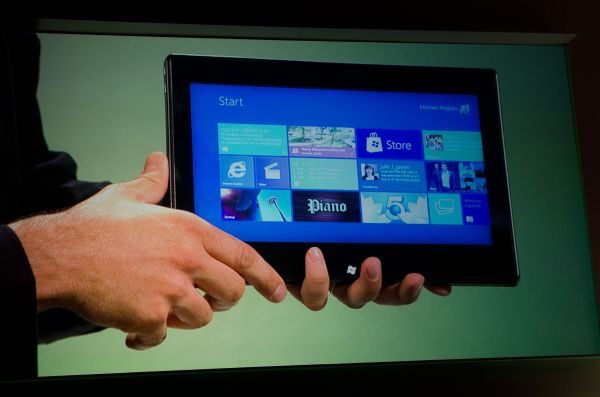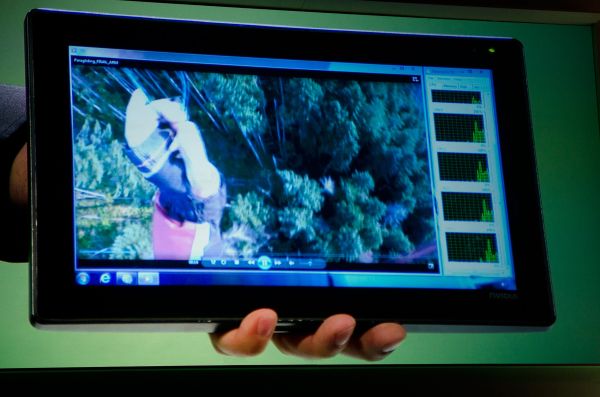Windows 8 Running on ARM, NVIDIA Kal-El Notebook Demoed
by Anand Lal Shimpi on June 1, 2011 10:54 PM EST- Posted in
- Trade Shows
- Microsoft
- Kal-El
- Computex 2011
- Windows 8
- NVIDIA
Microsoft just showed Windows 8 running on three different ARM platforms: a single-core 1.2GHz Qualcomm Snapdragon, a dual-core TI OMAP 4430 and a quad-core NVIDIA Kal-El notebook.
The same interface we showed you earlier exists on these systems, and the same applications can run across both systems (assuming the apps have been ported to ARM).
You get a standard Windows 8 desktop as well as the new tiled start screen. USB devices will work and MS even did a demo of copying files off of a USB thumb drive.
NVIDIA had a Kal-El based notebook and tablet on display. Microsoft showed task manager displaying all four threads during H.264 decode acceleration.



















19 Comments
View All Comments
MarkLuvsCS - Wednesday, June 1, 2011 - link
A demo of Kal-El at least shows they have it up and running. If they can get a bit better battery life with that seemingly smooth playback of 1080p utilizing around ~50% of 4 cores. Hopefully we'll see some new tablets before the end of the year!Guspaz - Thursday, June 2, 2011 - link
50% of four cores to play 1080p video is a big problem, because they shouldn't be doing video decoding on the CPU. Offloading video is extremely important on an SoC platform.ganeshts - Wednesday, June 1, 2011 - link
I just hope it is a sign of immature drivers :)Ideally the usage on all the 4 threads should be close to 0 (The 'VPU' engine should do the full decode acceleration)
yyrkoon - Thursday, June 2, 2011 - link
You forgot the most important part.ARM prides its self in low power consumption. ARM A9 ( or is it really A15 . . .4 cores . ..) has very light power consumption. I do not know about this particular processor/setup, but it would not be too much of a stretch to think this setup is using 2-4 WATTs. Before LCD screen usage.
There have been demos of ARM A9 dual core beta products using 2W while doing the same task. Though in Chrome OS. 2W while playing back video. Without dropping frames.
After that. Considering that a Tegra 3 system can be comparable to a Core 2 LUV system in performance . . . Well, lets just say "Atom who?".
micksh - Thursday, June 2, 2011 - link
You forgot the most important part.DSP normally does most of of the video decoding on ARM. If DSP was utilized CPU usage and power consumption should have been lower.
If iPad CPU used 2 Watt during video decoding it would not have been able to provide 10 hours of video playback. It's got 25 watt-hour battery and display consumes most of it.
CPU+DSP+everything else have to consume less than 1 Watt for good battery life.
micksh - Thursday, June 2, 2011 - link
"CPU+DSP+everything else have to consume less than 1 Watt."Except display, of course, I should clarify. Display will consume 1-1.5 Watt.
It's hard to do that without DSP and it's hard to fit more than 25 watt-hour battery in slim tablet. So they better have DSP drivers working.
yyrkoon - Friday, June 3, 2011 - link
Key word; notebook. Not a tablet. I doubt very seriously the iPad will compete performance wise with an e7300 CPU performance wise.yyrkoon - Friday, June 3, 2011 - link
Also, let us not forget, this is still early stage. Microsoft probably has not optimized is software for ARM just yet. Drivers probably could use some work too.Still even though I think low power is great, there comes a point when too low, is . . .well too low, and performance then should be given more consideration.
Guspaz - Thursday, June 2, 2011 - link
Windows on ARM is interesting, but Microsoft has been skating around any sort of question about compatibility. Obviously anything .NET is going to work fine, but what about everything else? They've been hinting (but I don't think outright confirmed without later hedging) that they'll not have any sort of emulation for x86 core. What, then, about fat/universal style binaries? What will they be doing to ensure that there's actually software to run on these things?softdrinkviking - Thursday, June 2, 2011 - link
Could you give an example if something not .net that is really important for Win8 to succeed on ARM?There must be plenty of ARM based software out there already, and I would hope the quality will get better now that MS has signed on.
I guess I'm still a little confused about the supposed cross-platform compatability of Win8. Will we really have to get different programs for an ARM vs an X86 variant?
I can see that becoming a real bummer, especially if you happen to own an ARM tablet and an X86 desktop.